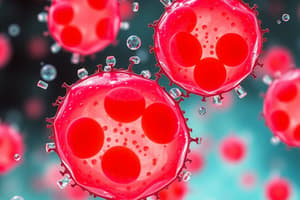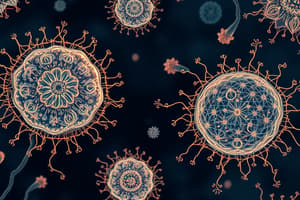Podcast
Questions and Answers
Which of the following best describes the relationship between observation, hypothesis, and theory in the scientific method?
Which of the following best describes the relationship between observation, hypothesis, and theory in the scientific method?
- A theory is a speculative guess that, after repeated observation, becomes a hypothesis, and is finally proven.
- An observation leads to a hypothesis, which is a testable explanation; a theory is a well-substantiated explanation broader in scope than a hypothesis. (correct)
- Observations are irrelevant to theory formation; theories are based solely on hypotheses.
- A hypothesis is a proven fact that leads to observations supporting a broader theory.
If a researcher discovers a new element essential for life, but only in very small quantities, this element would be classified as a:
If a researcher discovers a new element essential for life, but only in very small quantities, this element would be classified as a:
- Radioisotope
- Trace element (correct)
- Macronutrient
- Catalyst
Which of the following statements accurately compares and contrasts saturated and unsaturated fats?
Which of the following statements accurately compares and contrasts saturated and unsaturated fats?
- Saturated fats have fatty acid tails with no carbon-carbon double bonds, allowing them to pack tightly, whereas unsaturated fats have one or more double bonds that create kinks in the tails. (correct)
- Both saturated and unsaturated fats are equally healthy, and their consumption should be unlimited in a balanced diet.
- Unsaturated fats are typically solid at room temperature due to the tight packing of their fatty acid tails.
- Saturated fats contain more carbon-carbon double bonds than unsaturated fats, leading to a higher melting point.
A scientist is studying a molecule and determines that it is polar and soluble in water. Which of the following characteristics would you expect to find in this molecule?
A scientist is studying a molecule and determines that it is polar and soluble in water. Which of the following characteristics would you expect to find in this molecule?
If the pH of blood is carefully maintained at around 7.4, what might happen if the blood pH were to drop to 7.0?
If the pH of blood is carefully maintained at around 7.4, what might happen if the blood pH were to drop to 7.0?
Flashcards
Biological Organization Hierarchy
Biological Organization Hierarchy
Arrangement of life from atoms to biosphere, each level gaining new properties.
Prokaryotic Cell
Prokaryotic Cell
Cells lacking a nucleus or other complex organelles. (e.g., Bacteria)
Hypothesis
Hypothesis
A testable explanation for a set of observations.
Most Important Elements to Life
Most Important Elements to Life
Signup and view all the flashcards
Cohesion
Cohesion
Signup and view all the flashcards
Study Notes
- Biological organization is hierarchical, increasing in complexity from atoms to molecules, cells, tissues, organs, organ systems, organisms, populations, communities, ecosystems, and the biosphere.
- Life is generally considered to begin at the cellular level in this hierarchy.
Prokaryotes vs. Eukaryotes
- Prokaryotes are generally smaller and simpler cells lacking a nucleus and other membrane-bound organelles; bacteria and archaea are examples.
- Eukaryotes are larger and more complex cells possessing a nucleus and other membrane-bound organelles; examples include protists, fungi, plants, and animals.
Scientific Terminology
- An observation is a direct or indirect gathering of information.
- A scientific law is a descriptive generalization about how some aspect of the natural world behaves under stated circumstances.
- A theory is a broad explanation for events that is widely accepted.
- A scientific fact is an objective and verifiable observation.
- A hypothesis is a testable explanation for a set of observations; an "educated guess".
Key Elements of Life
- The most important elements for life include carbon, hydrogen, oxygen, nitrogen, phosphorus, and sulfur (CHNOPS).
- Trace elements are required by an organism in only minute quantities.
Atoms and Molecules
- An atom is the smallest unit of matter that retains the chemical properties of an element.
- An element is a substance that cannot be broken down into other substances by chemical reactions.
- A compound consists of two or more different elements combined in a fixed ratio.
- An ion is an atom or molecule that has gained or lost one or more electrons, giving it an electrical charge.
- A molecule is two or more atoms held together by covalent bonds.
- A mixture is a combination of two or more substances that are physically combined.
Subatomic Particles
- Protons have a positive charge and are located in the nucleus.
- Neutrons are neutral and are located in the nucleus.
- Electrons have a negative charge and orbit the nucleus.
Atomic Number and Mass Number
- The atomic number is the number of protons in an atom's nucleus, which determines the element.
- The mass number is the sum of protons and neutrons in an atom's nucleus.
- An isotope is a variant of an element that has the same number of protons but a different number of neutrons, thus varying in atomic mass.
Bonding Types
- A hydrogen bond is a weak attraction between a hydrogen atom bound to an electronegative atom and another electronegative atom; example: water molecules.
- A covalent bond is the sharing of electron pairs between atoms; example: methane (CH4).
- An ionic bond is the attraction between oppositely charged ions; example: sodium chloride (NaCl).
- Van der Waals interactions are weak, short-range attractions between atoms and molecules due to temporary fluctuations in electron distribution; example: gecko feet clinging to surfaces.
- A peptide bond is a covalent bond between two amino acids; example: the bonds in a polypeptide chain.
Polarity
- Polarity is a property of a molecule having regions with partial positive and negative charges due to uneven sharing of electrons in covalent bonds.
Hydrophobicity and Hydrophilicity
- Hydrophobicity is the tendency to repel water; hydrophobic substances are nonpolar and do not dissolve in water.
- Hydrophilicity is the tendency to be attracted to water; hydrophilic substances are polar and dissolve in water.
- Lipophilic refers to the ability to dissolve in lipids or fats (similar to hydrophobic).
- Lipophobic refers to the inability to dissolve in lipids or fats (similar to hydrophilic).
- Lipophilic and hydrophobic are often used interchangeably, as are lipophobic and hydrophilic.
Solubility
- Soluble means capable of being dissolved in a solvent.
- Insoluble means incapable of being dissolved in a solvent.
Unique Properties of Water
- Water's remarkable properties stem from its polarity and hydrogen bonding.
Cohesion and Adhesion
- Cohesion is the attraction between molecules of the same substance; water molecules exhibit strong cohesion.
- Adhesion is the attraction between molecules of different substances; water adheres to hydrophilic surfaces.
DNA, RNA, and Protein
- DNA (deoxyribonucleic acid) comprises two strands composed of nucleotide building blocks arranged in a double helix that stores genetic information.
- RNA (ribonucleic acid) is a typically single-stranded nucleic acid composed of nucleotide building blocks that mediate gene expression.
- Protein is composed of amino acid building blocks and arranged in complex 3D structures that perform a wide range of functions.
Blood pH
- The pH of blood is maintained around 7.4.
- Buffers, such as the bicarbonate buffer system, maintain blood pH.
- Sodium bicarbonate (NaHCO3) is a salt that can act as a buffer to resist changes in pH.
Molecular Structures (Groups)
- Carboxylic acid: -COOH
- Hydroxyl: -OH
- Amino: -NH2
- Methyl: -CH3
- Ketone: C=O (within a carbon skeleton)
- Aldehyde: C=O (at the end of a carbon skeleton)
Major Macromolecules
- The four major macromolecules are carbohydrates, lipids, proteins, and nucleic acids.
- The building blocks (monomers) are:
- monosaccharides for carbohydrates,
- fatty acids and glycerol for lipids,
- amino acids for proteins,
- nucleotides for nucleic acids.
- Lipids are not polymers because they are not formed by the linking of similar repeating units.
- A polymer is a large molecule consisting of many similar or identical monomers linked together by covalent bonds.
Polysaccharides and Fats
- Starch is a polysaccharide used for energy storage in plants.
- Glycogen is a polysaccharide used for energy storage in animals.
- Cellulose is a polysaccharide that is a major component of plant cell walls.
- Fat is a lipid composed of glycerol and fatty acids, used for energy storage, insulation, and protection.
Condensation and Hydrolysis
- Condensation, or dehydration synthesis, is the process by which monomers are joined to form polymers through the removal of a water molecule.
- Degradation by hydrolysis is the process by which polymers are broken down into monomers through the addition of a water molecule.
Steroid vs. Protein Hormones
- Steroid hormones are lipids derived from cholesterol that can pass through the cell membrane to bind to intracellular receptors.
- Protein hormones are composed of amino acids and bind to receptors on the cell surface, triggering a signaling cascade.
- Cholesterol is a precursor molecule for steroid hormones.
The pH Scale
- The pH scale measures the acidity or alkalinity of a solution.
- It measures the concentration of hydrogen ions (H+).
- The pH scale is logarithmic, meaning each whole number change represents a tenfold difference in hydrogen ion concentration.
Saturated vs. Unsaturated Fat
- Saturated fats have no double bonds between carbon atoms in their fatty acid tails, allowing them to pack tightly and be solid at room temperature.
- Unsaturated fats have one or more double bonds between carbon atoms in their fatty acid tails, causing kinks that prevent them from packing tightly, making them liquid at room temperature.
Charles Darwin's Theory
- Charles Darwin theorized that evolution occurs through natural selection.
- Natural selection is the process by which individuals with traits better suited to their environment survive and reproduce at higher rates, leading to the accumulation of advantageous traits in a population over time.
Plant vs. Animal Kingdoms
- Plants are generally autotrophic, using photosynthesis to produce their own food, and have cell walls made of cellulose.
- Animals are heterotrophic, obtaining nutrients by consuming other organisms, and lack cell walls.
Studying That Suits You
Use AI to generate personalized quizzes and flashcards to suit your learning preferences.




